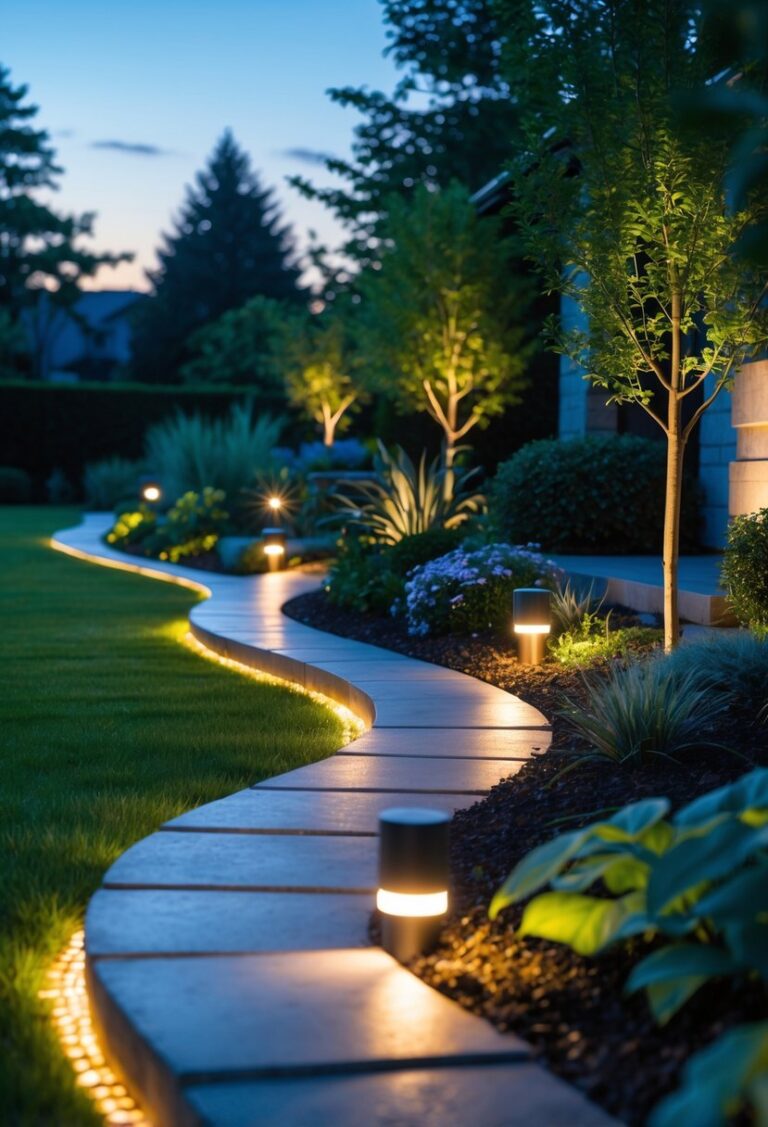10 Modern & Budget-Friendly Lawn Edging Designs Ideas
Lawn edging is a simple way to improve the look of your yard by creating clear borders between your lawn, flower beds, and other areas. It helps keep your garden neat and can give your outdoor space a polished feel without much effort.

You can choose from many edging options that fit your style, budget, and maintenance needs to make your lawn look well-kept and organized. This article will share 10 lawn edging ideas to help you find the right option for your garden.
1. Brick edging for a classic, durable border

You can use brick edging to create a strong and lasting border around your lawn. Bricks are easy to install and hold their shape well over time.
This type of edging keeps grass from spreading into garden beds. It also gives your yard a clean, organized look that fits many styles.
2. Metal strip edging for a sleek, modern look

You can use metal strip edging to create clean, straight lines around your lawn or flower beds. It gives a modern, minimal style that fits well with contemporary gardens.
Materials like steel or aluminum are strong and last a long time. They resist rust and stay firmly in place, keeping grass from spreading into flower beds.
3. Natural stone edging for rustic charm

You can use natural stone edging to add a simple, rustic look to your garden. Stones like river rock or fieldstone make clear borders that blend well with plants.
This type of edging is both sturdy and low maintenance. It works well to define flower beds or pathways while keeping a natural feel in your yard.
4. Gravel edging for a budget-friendly option

Gravel edging is an affordable way to define your lawn and garden beds. It helps stop grass and soil from spreading into unwanted areas.
You can use different gravel sizes and colors to match your yard’s style. Gravel is easy to install and requires little upkeep.
This option works well for driveway edges or paths too. Just keep in mind gravel may need occasional raking to stay neat.
5. Wooden log edging to enhance natural appeal

You can use wooden log edging to give your garden a simple, natural look. Logs create a rustic border that works well with flowers and vegetable beds.
This type of edging blends into outdoor spaces and is easy to install. It also adds texture and helps define your garden clearly.
6. Concrete curbing for a clean, permanent edge

Concrete curbing gives your lawn a neat, lasting border. It helps keep grass out of flower beds and makes mowing easier.
You can shape the concrete to fit your style and yard design. This option is durable and requires little maintenance once installed.
7. Plastic lawn edging for easy installation

You can install plastic lawn edging quickly and with little effort. It is lightweight and flexible, so you can shape it to fit curves and corners in your yard.
Measure your garden bed first, then dig a shallow trench to place the edging firmly. Plastic edging is cost-effective but may not last as long as metal or stone options.
8. Pound-in steel edging for flexible garden design

You can use pound-in steel edging to create clean, flexible borders for your garden. It bends easily, so it fits curved or straight shapes. This type of edging is strong and holds up well outdoors.
Installation is simple — just pound the steel into the ground along your desired line. It keeps grass and soil in place, helping your garden look neat and organized.
9. Cobblestone edging for timeless elegance

You can add a classic look to your lawn with cobblestone edging. These stones bring a simple, old-world charm that lasts for years.
Installation is easy—you just dig a shallow trench, place the stones, and fill the gaps with soil or sand. Cobblestone borders help define your garden without needing much upkeep.
10. Flower bed borders using recycled materials

You can create flower bed borders using recycled materials like old bricks, glass bottles, or wood. These options help reduce waste and add a unique look to your garden.
Using recycled items is cost-effective. Plus, you can customize the size and shape to fit your flower beds perfectly.
Choosing the Right Lawn Edging Style
Choosing the best lawn edging depends on your yard’s layout, the materials you prefer, and how much maintenance you want to do. You also need to think about how the edging will fit with your existing garden design.
Factors to Consider Before Installation
Start by looking at your yard’s shape. Curved edges work well with natural stone or flexible plastic, while straight lines are easier with bricks or concrete.
Think about durability. Metal and concrete last long but may cost more. Plastic and wood are cheaper but might need replacing sooner.
Maintenance matters too. Some materials require regular cleaning or sealing, like wood or brick. Others, like metal or stone, need less upkeep.
Finally, consider your budget. Prices vary widely, so pick edging that fits your style and how much you want to spend.
Installation and Maintenance Tips
Proper setup and care of your lawn edging will help keep your yard looking sharp and reduce extra work later. Pay attention to how you install the edging and how you maintain it to avoid common problems.
Common Installation Mistakes to Avoid
One major mistake is not digging a deep enough trench for your edging. Make sure the trench is at least half the height of the edging material to keep it stable. If it’s too shallow, the edging can shift or fall over.
Another mistake is failing to create a smooth, even base. Uneven ground causes gaps and uneven edges, making your yard look messy. Use a level or straight board when placing your edging.
Also, don’t forget to compact the soil around the edging after installation. Loose soil can cause the edging to move or sink in over time.
Finally, avoid cutting corners by skipping proper alignment. Take your time to measure and lay out the edging before installing to get clean, straight lines.

